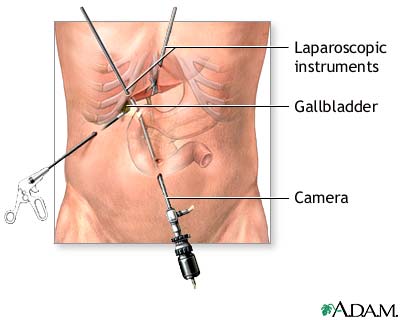
What is duodenal biliary drainage?
Duodenal biliary drainage is a little-used procedure that sometimes can be helpful in diagnosing gallstones.
How is duodenal biliary drainage done?
For duodenal biliary drainage, a thin plastic or rubber tube with several holes at its tip is passed through a patient's anesthetized nostril, down the back of the throat, through the esophagus and stomach, and into the duodenum where the bile and pancreatic ducts enter the small intestine. This is accomplished with the help of fluoroscopy, a type of X-ray. Once the tube is in place, a synthetic hormone related to cholecystokinin is injected intravenously. The hormone causes the gallbladder to contract and squeeze out its concentrated bile into the duodenum. The bile then is sucked up through the tube and examined for the presence of cholesterol and pigment particles under a microscope.
A modification of duodenal biliary drainage involves collection of bile through an endoscope at the time of an upper gastrointestinal endoscopy -- either by EGD (esophagogastroduodenoscopy) or by ERCP (endoscopic retrograde cholangio-pancreatography).
Why might duodenal biliary drainage be done?
Gallstones begin as microscopic particles of cholesterol or pigment that grow in size. Once the particles grow large enough to become gallstones, they can obstruct the bile ducts and cause problems. It is clear that some people who develop the symptoms and complications of gallstones -- biliary colic, cholecystitis, or pancreatitis -- have only these microscopic particles in their gallbladders, particles too small to obstruct the bile ducts.
There are two possible explanations for how obstruction might be occurring in this situation. The first is that a small gallstone obstructed the bile ducts but finally passed through the bile ducts into the intestine. The second is that the particles passing through the bile ducts "irritate" the ducts, causing spasm of the muscle within the walls of the ducts (which obstructs the duct) or causing inflammation of the duct so that the wall of the duct swells (which also obstructs the duct).
What are the risks of duodenal biliary drainage?
The risks to the patient of duodenal biliary drainage are almost nonexistent. There have been no reports of reactions to the synthetic hormone. Nevertheless, the presence of the tube in the throat is uncomfortable for the 30-60 minutes that are necessary to complete the test.

When is duodenal biliary drainage useful?
Duodenal biliary drainage is useful in diagnosing problems related to gallstones when other tests such as ultrasonography have not demonstrated gallstones but suspicion is high that gallstones are the cause of the patient's problem. Cholesterol or pigment particles without gallstones may be present in individuals who have no medical problems or problems that are not due to gallstones. It is unclear whether these individuals ultimately are more likely to develop gallstones. Because such individuals exist, it also is important not to assume that particles mean that gallstones are the cause of a medical problem. The medical problem and its symptoms should be typical of the types of problems caused by gallstones.
Previous contributing editors: Barbara K. Hecht, Ph.D. and Frederick Hecht, M.D.
sourceLast Editorial Review: 2/26/2009
|
Bookmark this post:
|
|

0 comments
Post a Comment